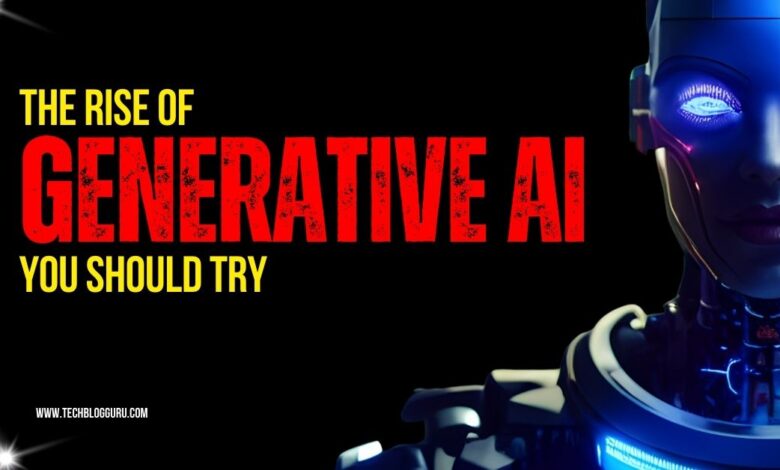The Rise of Generative AI: Transforming Industries and Inspiring Innovation

Table of Contents
What Is Generative AI?

Generative AI means using special types of artificial intelligence to help machines create content that looks a lot like what humans make. It’s like adding a touch of creativity to our digital friends! This technology has many uses, including the tasks in the table below.
| Function | Description |
|---|---|
| Text Generation | AI systems can create interesting stories, poems, or even pieces of code. |
| Image Synthesis | Generative AI can generate life like images, artwork, and even deepfake videos. |
| Music Composition | Machines are capable of composing melodies and harmonies that can evoke emotions. |
Applications and Opportunities
The table outlines various roles and their respective descriptions in leveraging generative AI technology. It highlights the diverse applications and opportunities available across different fields. From AI researchers pioneering advanced models to content creators innovating with storytelling, and from data scientists extracting insights to AI ethics consultants addressing ethical considerations, each role plays a crucial part in harnessing the potential of generative AI in today’s landscape.
| Role | Description |
|---|---|
| AI Researcher | Delve into the development of advanced generative models. Explore new architectures, loss functions, and training methods. Your contributions could shape the future of AI creativity. |
| Data Scientist | Utilize generative AI to derive meaningful insights from data. Picture generating synthetic data for model training or refining data augmentation techniques. |
| Content Creator | Unleash your creativity! Employ generative AI for inventive storytelling, personalized marketing materials, or game development. Envision AI-generated characters and plot twists. |
| AI Ethics Consultant | As generative AI becomes more widespread, ethical dilemmas emerge. Tackle concerns regarding bias, transparency, and accountability in AI-generated content. |
Computing Power: The Backbone of Tomorrow

Keep an eye on another emerging trend: the continuous rise in computing power. Our devices crave more processing strength, and we’re ready to provide it! Here’s what’s happening.
| Trend | Description |
|---|---|
| 6G | Get ready for the next generation of wireless technology! 6G brings lightning-fast speeds, minimal delays, and seamless connections, transforming IoT and augmented reality. |
| Edge Computing | Devices are getting smarter with edge computing, which brings computation closer to data sources like smart cars, drones, and wearables. Anticipate a rise in edge-related careers. |
| Quantum Computing | Quantum bits (qubits) are set to redefine computation. With quantum supremacy on the horizon, quantum algorithms will tackle complex problems like never before. |
Conclusion
In summary, Generative AI is an innovative form of artificial intelligence. It can create content like humans do, offering new opportunities in art, literature, and music. We must also consider its ethical impact and use it responsibly. With more research and ethical thinking, Generative AI could change how humans and machines interact in the future.
You Might Also Like To Read
Is Your iPhone Ready for iOS 18 Update? Get the Latest Rumor Roundup.
Google Messages Contact Details Page: Enhance Your New Messaging Experience.
FAQ’s
What is Generative AI?
Generative AI refers to a type of artificial intelligence technology that enables machines to create content, such as images, text, or music, that resembles human-generated work. It uses algorithms to generate new data based on patterns learned from existing data.
How does Generative AI work?
Generative AI works by training neural networks on large datasets to learn patterns and structures. These networks then generate new content by extrapolating from the learned patterns. For example, a text-based Generative AI model might learn the structure of sentences and paragraphs from a corpus of text and then generate new text based on that knowledge.
What are the applications of Generative AI?
Generative AI has a wide range of applications across various industries. It can be used for creating realistic images, generating personalized content for marketing purposes, composing music, enhancing data augmentation techniques in machine learning, and even producing deepfake videos for entertainment or educational purposes.
What are the ethical considerations surrounding Generative AI?
Ethical considerations related to Generative AI include issues such as the potential for misuse, privacy concerns related to the generation of realistic synthetic data, and the impact on jobs and creative industries. There are also concerns about bias in the data used to train Generative AI models and the transparency of generated content.
How can businesses leverage Generative AI?
Businesses can leverage Generative AI to enhance creativity, improve customer engagement, and streamline processes. For example, they can use it to generate personalized content for marketing campaigns, create virtual prototypes of products, or automate repetitive tasks such as image or text generation. However, businesses must also consider the ethical implications and potential risks associated with using Generative AI technologies.




